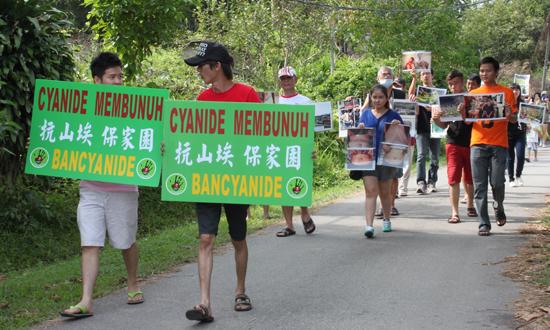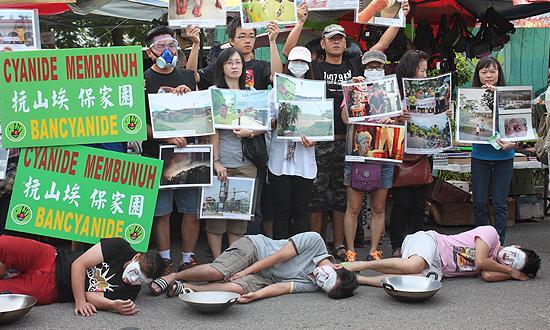LETTER | Sahabat Alam Malaysia (SAM) is outraged by the Water, Land and Natural Resources Minister Dr Xavier Jayakumar’s statement that cyanide used by three gold mining companies in Malaysia does not cause any health problems such as cancer or skin diseases and that cyanide used at the mining ponds has no impact on the air or the nearby environment.
He was also quoted by the media that “no matter where you put cyanide, it will evaporate and turn into carbon dioxide, it has no smell.”
We deeply regret that the statement made by the minister has been made without any proper understanding of the impacts of cyanide usage in the carbon-in-leach process in a factory that is situated in a residential area or the history of complaints made by the Bukit Koman community for the last eight years or so since Raub Australian Gold Mining Sdn Bhd (RAGM) began operations in February 2009.
The operations have ceased as the company has been voluntarily wound up.
Community's health complaints over eight years
The Minister’s statement only shows the insensitive attitude of the government in dismissing the complaints and health problems of the Bukit Koman residents.
These residents have countless times complained about being exposed to noxious substances. They have suffered from nausea, headache, eye irritation, itchiness and rashes, and a general malaise in the community.
The cause for these medical problems was never determined nor investigated thoroughly by the government.
Between July 15 and 17, 2009, SAM conducted a health survey in the surroundings of Kampung Bukit Koman. About 291 people took part in this survey, 167 women and 124 men.

The survey report showed that 206 people complained of skin irritation or itchiness, 190 suffered eye irritation or watery eyes, 169 had difficulties in breathing, 137 complained of sleeping difficulties every time the noxious substance is release, 136 complained of dizziness and 125 suffered frequent headaches.
Some of them also experienced coughs and throat dryness. Only eight of the people surveyed did not have any of the symptoms listed in the survey and among them, were those staying far from the facility and also those who kept their windows and doors closed and remained indoors whenever they sensed the noxious smell.
Similarly, the Ban Cyanide Action Committee also conducted a survey in 2012 and released results that showed there were many who complained of various medical problems after RAGM began operations.
The only assumption the residents can make is that their health problems have been due to the mining facility because they had never experienced such problems prior to the operation of RAGM.
As a minister of a newly elected government and one that the people overwhelmingly voted for, statements like this should not have been made in Parliament as it only showed that the government summarily dismissed those who have been impacted and affected by RAGM.
Instead, the Minister should have first studied and understood the issues surrounding the usage of cyanide in the processing of gold.
In 2008, we at SAM raised our concerns on the 1997 Preliminary Environment Impact Assessment prepared and submitted by RAGM to the Department of Environment (DoE).
Experts say cyanide remains for extended periods
We had submitted our comments to DoE based on the expert report of two leading American scientists, Glenn C Miller and Mark Chernaik. SAM was advised by Miller that cyanide complexes are less susceptible to degradation, and remained in the fluids and tailings for extended periods of time.
At high pH, arsenic and antimony are soluble, and nitrate, salts and a variety of other substances would be present and this would present greater long-term concerns to surface and ground water.

Cyanide may cause the greatest immediate concern in the community, however, the longer term protection of human health and the environment must recognise the issues with the other contaminants. Hence, it not just about the usage of cyanide only.
SAM is disappointed that to date, the government has totally missed the point and has failed to address the issue surrounding the actual impacts of the usage of cyanide in such a process in a facility in very close proximity to a residential area.
Who's paying for the decommissioning of mines?
Further, one of the conditions in the mining lease under the Pahang Mineral Enactment states that the lessee should undertake the rehabilitation process of the mine in line with the conditions approved by the State Mineral Resources Committee. Additionally, Principle Five of the International Cyanide Management Code states:
“Decommissioning: Protect communities and the environment from cyanide through development and implementation of decommissioning plans for cyanide facilities.
Standards of Practice:
5.1 Plan and implement procedures for effective decommissioning of cyanide facilities to protect human health, wildlife and livestock.
5.2 Establish an assurance mechanism capable of fully funding cyanide-related decommissioning activities.”
To date, neither SAM nor the Bukit Koman community know whether this process has started and who would pay for the decommissioning and rehabilitation process now that RAGM has been voluntarily wound up by its creditors.
Letters to the previous government on this have not been answered.
SAM urges the government to:
- set up a taskforce with the community and other experts in toxicology and mining issues to investigate the source of the health problems of the community in Bukit Koman, and,
- to begin the decommissioning process for this facility in line with established international standards.
Editor's note: The RAGM has consistently denied all the allegations made against the plant and its effects.
The writer is president of Sahabat Alam Malaysia
The views expressed here are those of the author/contributor and do not necessarily represent the views of Malaysiakini.

